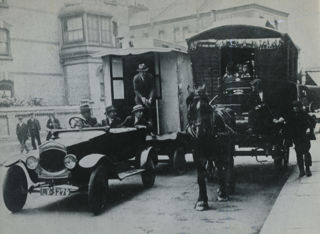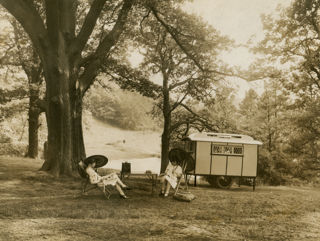
The First Trailer Caravan
05 May 2022
Who built the first caravan to be towed by a motor car? Explore the birth of the trailer caravan in the years after the First World War.
In the Edwardian era there was a new craze sweeping the wealthy and leisured classes of Britain; horse-drawn leisure caravanning. By 1907 the hobby was so popular that the then Caravan Club of Great Britain and Ireland (now known as the Caravan and Motorhome Club) was formed to represent the growing number of horse-drawn caravanners. Yet in the years before the First World War a handful of motor caravans began to appear at Club events. These large vehicles with a self-contained living space were seen as quite a novelty, and for some the future of caravanning, but as Club founder J Harris Stone noted the developments in technology in this area was quite slow. It did not appear that anything would rival the horse-drawn caravan any time soon.

What had not been foreseen in the future of caravanning was the entirely new concept of a trailer caravan towed behind a motor car. The very first trailer caravan designed for this purpose was reported to have been built in 1914 by Frederick Alcock, an adventurous early motorist and friend of pioneering car manufacturers the Lanchester brothers. However, the quest to find hard evidence to back up these anecdotes is ongoing. It is said that the caravan body was mounted on a 1909 Lanchester axle, and this he towed with a 1913 Lanchester Landaulette.
In any case, before 1914 any prediction of how the future of caravanning would look would have undoubtedly been placed on the motor caravan. However, the devastating conflict of the First World War brought about huge developments in motorised technology and for the first time trailers were developed to be towed behind motor vehicles in support of work on the front line (you can find out more about the role played by the caravan in the First World War here).

In 1919 once peace was restored, the first commercially produced trailer caravan appeared in the UK. It was the brainchild of Cambridge student Captain Richard St Barbe Baker, an Army Officer who had been injured in the conflict and held the tragic legacy of being the only Officer amongst his fellows in the First Divisional Artillery to return home. St Barbe Baker later recalled the incredible story of how a vivid dream of a trailer caravan being made from aircraft parts led to his enterprise. On going down to breakfast the very next morning he read a Government Disposals Board advertisement in The Times which was selling off ex-war aircraft parts.
Richard set off at once to see what was on offer at Whaddon dump at Croydon. He later recalled in his publication Man of the Trees that “I was thinking only in terms of one caravan so when the clerk asked what I wanted I replied: “To begin with a couple of aeroplane undercarriages”. “A couple” he exclaimed. “This is the Government Disposals Board. The smallest lot is 36”!
Ten days later ten truckloads of unwanted aircraft materials arrived in Cambridge and Richard quickly delivered them to a local a motor body builder and set about designing a caravan fit to be towed by a motor car. The caravan was built on an aeroplane undercarriage with four wheels, it featured a lantern roof similar to horse-drawn leisure caravans of the day, little windows and a stable door.
Taking its first outing in May 1919 the ‘Navarac’ as it was called, met much attention, featuring the following day on newsreels in cinemas across the country. The caravan was soon in demand and thanks to the inexpensive surplus parts used in its construction they were sold with a 100% profit margin.
The Navarac enterprise was short-lived however, its downfall being the decision to place it on exhibition at Olympia. As a result the idea quickly spread and new businesses overtook the company in design and practicality. St Barbe Baker went back to focussing on his first passion of forestry, later founding Men of the Trees, an organisation which promotes reforestation worldwide and receiving an OBE for his work.

This remarkable Navarac trailer caravan kick started an enthusiasm for caravanning with a motor car that was to grow throughout the 1920s. It paved the way for numerous well-known caravan manufacturers including Eccles, Car Cruiser, Winchester and Cheltenham who firmly established the popularity of leisure caravan touring which lasts to this day.

Subscribe for updates
Get our latest news and events straight to your inbox.